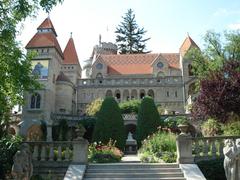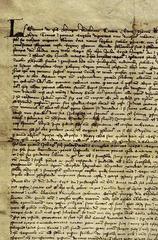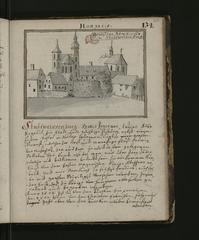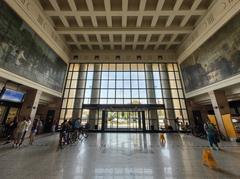Episcopal Palace of Székesfehérvár: Visiting Hours, Tickets, and Historical Sites Guide
Date: 04/07/2025
Introduction
The Episcopal Palace of Székesfehérvár is a striking testament to Hungary’s royal and ecclesiastical heritage, nestled in the historic heart of Székesfehérvár’s Old Town. Revered as the “City of Kings,” Székesfehérvár served as the coronation and burial site for Hungarian monarchs, including King Saint Stephen I, the nation’s first king. Today, the palace stands as an architectural jewel, reflecting centuries of transformation—from medieval grandeur and Ottoman devastation to Habsburg-era revival.
This guide provides a comprehensive overview of the palace’s historical significance, architectural evolution, and practical visitor information. Whether drawn by its grand façade, the opulent interiors (when accessible), or the archaeological remnants of the adjacent Coronation Basilica, this resource is your key to exploring one of Székesfehérvár’s most iconic landmarks.
For the latest updates on opening hours, tickets, and special events, consult official tourism and museum platforms (culturaltourism.hu; turizmus.szekesfehervar.hu; mywanderlust.pl; Muzej.hu).
Table of Contents
- Historical Background and Architectural Evolution
- Visitor Information
- Artistic Heritage and Interior Highlights
- FAQ
- Conclusion and Call to Action
- References
Historical Background and Architectural Evolution
Medieval Foundations and Royal Significance
Székesfehérvár’s origins date back to the late 10th century when Prince Géza established a royal seat here. The city was later elevated by King Saint Stephen I, who built the Basilica of the Assumption between 1003 and 1038 (culturaltourism.hu). This basilica became the spiritual and ceremonial heart of Hungary, witnessing the coronations and burials of numerous monarchs (mywanderlust.pl).
Destruction, Decline, and Habsburg Revival
The city’s prominence suffered during Ottoman occupation, culminating in the destruction of the basilica in 1702 by imperial forces (wikipedia). Habsburg rule ushered in a period of renewal, and Empress Maria Theresa’s decree in 1777 elevated Székesfehérvár to an episcopal seat, prompting the construction of the present palace (mywanderlust.pl).
Construction and Stylistic Development
The Episcopal Palace was built between the late 18th and early 19th centuries, incorporating stones from the ruined basilica to symbolize continuity (turizmus.szekesfehervar.hu). The architecture features a blend of Baroque, Louis Seize (Louis XVI), and Zopf elements, reflecting evolving tastes of the era (petitfute.co.uk).
- Baroque Style: Grand forms, elaborate ornamentation, and dynamic façades.
- Louis Seize/Neoclassical Influence: Symmetry, classical motifs, and restrained elegance.
- Zopf Elements: Lighter, playful ornamentation bridging Baroque and Neoclassicism.
Architect Jakab Riedel unified these styles, making the palace a leading example of Louis Seize architecture in Hungary (turizmus.szekesfehervar.hu).
Palace Gardens and Archaeological Layers
The palace gardens extend to the old castle wall and overlay unexplored sections of the medieval basilica, offering visitors a direct link to the city’s medieval roots (turizmus.szekesfehervar.hu).
The Palace in Urban and Cultural Life
Located on Városház Square, the palace anchors a district of Baroque and early Neoclassical buildings. It is a centerpiece for civic life, cultural events, and festivals, including the renowned Székesfehérvár Royal Days (info-budapest.com).
Visitor Information
Opening Hours
- Exterior & Gardens: Accessible daily, year-round.
- Interior Visits: Generally limited to special events, guided tours, or festivals. For updated access and opening times, check the official tourism portal (turizmus.szekesfehervar.hu).
Tickets and Admission
- Exterior & Gardens: Free.
- Interior Access: Tickets required for guided tours or special events; purchase at the site or via official channels. Group rates and foreign-language tours available; pricing and availability may vary (Muzej.hu).
- Sample Group Rates: “On the Path of Kings” guided program (includes palace and royal sites) from 34,000 HUF for up to 30 people (turizmus.szekesfehervar.hu).
Accessibility
- The palace grounds and Városház Square are accessible for visitors with mobility challenges.
- Some interior spaces may present barriers due to historic architecture; check ahead or request assistance.
Travel Tips and Best Times to Visit
- Best Light for Photography: Early morning or late afternoon.
- Ideal Seasons: Spring and early autumn for mild weather and fewer crowds.
- Events: August’s Székesfehérvár Royal Days for historical reenactments and cultural festivities.
- Guided Tours: Enhance your visit with local or group tours that provide historical context.
Nearby Attractions
- Coronation Basilica Ruins: Adjacent to the palace.
- St. Stephen’s Cathedral: Key religious site.
- King Stephen Museum & Hiemer House: Within walking distance.
- Bory Castle & Székesfehérvári Virágóra (Floral Clock): Noteworthy city highlights.
Artistic Heritage and Interior Highlights
When accessible, the palace’s interiors showcase:
- Empire and Biedermeier Furnishings: Elegant, period-appropriate décor (turizmus.szekesfehervar.hu).
- Frescoes and Murals: Notably by Franz Anton Maulbertsch, presenting dynamic Rococo scenes (Muzej.hu).
- Rococo and Baroque Details: Including Hungary’s largest Rococo tiled stove and ornate cabinetry.
- Library Hall: Home to approximately 40,000 volumes, including rare books and illuminated manuscripts.
- Hidden Features: Secret doors and passageways typical of Baroque palatial design.
FAQ
Q: What are the regular visiting hours?
A: The palace exterior and gardens are open daily. Interior access is by guided tour or during special events—confirm times via official sources.
Q: Is there an admission fee?
A: The exterior and gardens are free. Tickets are required for guided tours or exhibitions inside.
Q: Are guided tours available in English?
A: Yes, often available in English, German, and Hungarian. Advance booking is recommended.
Q: Is the palace accessible for visitors with disabilities?
A: The grounds and square are mostly accessible. Some historic interiors may pose challenges; inquire ahead for assistance.
Q: Can I take photographs?
A: Photography is allowed outdoors. Interior photography may be restricted.
Conclusion and Call to Action
The Episcopal Palace of Székesfehérvár encapsulates centuries of Hungarian history, art, and spirituality. Whether you’re admiring its façade and tranquil gardens, attending a festival, or exploring rare interior spaces, the palace offers a unique window into Hungary’s royal and religious past.
Plan your visit:
- Check official tourism portals for current opening hours and ticket information (turizmus.szekesfehervar.hu; Muzej.hu; petitfute.co.uk).
- Download the Audiala mobile app for audio guides, interactive maps, and event updates.
- Follow local social media and explore related articles for deeper insights.
Experience the timeless majesty of Székesfehérvár’s Episcopal Palace and immerse yourself in Hungary’s “City of Kings.”
References
- Discovering the Episcopal Palace of Székesfehérvár: History, Architecture, and Visitor Information (culturaltourism.hu)
- Historical Overview and Architectural Details (turizmus.szekesfehervar.hu)
- Visiting the Episcopal Palace: Practical Information (mywanderlust.pl)
- Artistic Heritage and Interior Decoration (Muzej.hu)
- Episcopal Palace Visitor Information (petitfute.co.uk)





